Tutorial: optimal binning with binary target¶
Basic¶
To get us started, let’s load a well-known dataset from the UCI repository and transform the data into a pandas.DataFrame.
[1]:
import numpy as np
import pandas as pd
from sklearn.datasets import load_breast_cancer
[2]:
data = load_breast_cancer()
df = pd.DataFrame(data.data, columns=data.feature_names)
We choose a variable to discretize and the binary target.
[3]:
variable = "mean radius"
x = df[variable].values
y = data.target
Import and instantiate an OptimalBinning object class. We pass the variable name, its data type, and a solver, in this case, we choose the constraint programming solver.
[4]:
from optbinning import OptimalBinning
[5]:
optb = OptimalBinning(name=variable, dtype="numerical", solver="cp")
We fit the optimal binning object with arrays x and y.
[6]:
optb.fit(x, y)
[6]:
OptimalBinning(name='mean radius')
You can check if an optimal solution has been found via the status attribute:
[7]:
optb.status
[7]:
'OPTIMAL'
You can also retrieve the optimal split points via the splits attribute:
[8]:
optb.splits
[8]:
array([11.42500019, 12.32999992, 13.09499979, 13.70499992, 15.04500008,
16.92500019])
The binning table¶
The optimal binning algorithms return a binning table; a binning table displays the binned data and several metrics for each bin. Class OptimalBinning returns an object BinningTable via the binning_table attribute.
[9]:
binning_table = optb.binning_table
[10]:
type(binning_table)
[10]:
optbinning.binning.binning_statistics.BinningTable
The binning_table is instantiated, but not built. Therefore, the first step is to call the method build, which returns a pandas.DataFrame.
[11]:
binning_table.build()
[11]:
| Bin | Count | Count (%) | Non-event | Event | Event rate | WoE | IV | JS | |
|---|---|---|---|---|---|---|---|---|---|
| 0 | (-inf, 11.43) | 118 | 0.207381 | 3 | 115 | 0.974576 | -3.125170 | 0.962483 | 0.087205 |
| 1 | [11.43, 12.33) | 79 | 0.138840 | 3 | 76 | 0.962025 | -2.710972 | 0.538763 | 0.052198 |
| 2 | [12.33, 13.09) | 68 | 0.119508 | 7 | 61 | 0.897059 | -1.643814 | 0.226599 | 0.025513 |
| 3 | [13.09, 13.70) | 49 | 0.086116 | 10 | 39 | 0.795918 | -0.839827 | 0.052131 | 0.006331 |
| 4 | [13.70, 15.05) | 83 | 0.145870 | 28 | 55 | 0.662651 | -0.153979 | 0.003385 | 0.000423 |
| 5 | [15.05, 16.93) | 54 | 0.094903 | 44 | 10 | 0.185185 | 2.002754 | 0.359566 | 0.038678 |
| 6 | [16.93, inf) | 118 | 0.207381 | 117 | 1 | 0.008475 | 5.283323 | 2.900997 | 0.183436 |
| 7 | Special | 0 | 0.000000 | 0 | 0 | 0.000000 | 0.000000 | 0.000000 | 0.000000 |
| 8 | Missing | 0 | 0.000000 | 0 | 0 | 0.000000 | 0.000000 | 0.000000 | 0.000000 |
| Totals | 569 | 1.000000 | 212 | 357 | 0.627417 | 5.043925 | 0.393784 |
Let’s describe the columns of this binning table:
Bin: the intervals delimited by the optimal split points.
Count: the number of records for each bin.
Count (%): the percentage of records for each bin.
Non-event: the number of non-event records \((y = 0)\) for each bin.
Event: the number of event records \((y = 1)\) for each bin.
Event rate: the percentage of event records for each bin.
WoE: the Weight-of-Evidence for each bin.
IV: the Information Value (also known as Jeffrey’s divergence) for each bin.
JS: the Jensen-Shannon divergence for each bin.
The last row shows the total number of records, non-event records, event records, and IV and JS.
You can use the method plot to visualize the histogram and WoE or event rate curve. Note that the Bin ID corresponds to the binning table index.
[12]:
binning_table.plot(metric="woe")
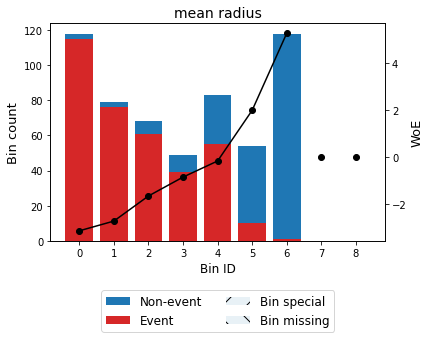
[13]:
binning_table.plot(metric="event_rate")
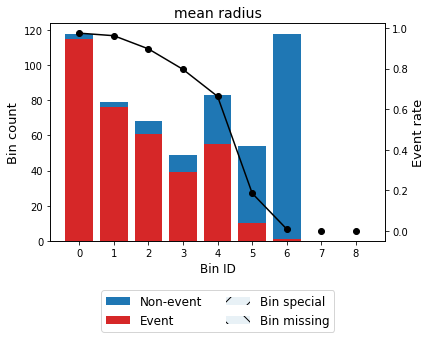
Note that WoE is inversely related to the event rate, i.e., a monotonically ascending event rate ensures a monotonically descending WoE and vice-versa. We will see more monotonic trend options in the advanced tutorial.
Event rate / WoE transformation¶
Now that we have checked the binned data, we can transform our original data into WoE or event rate values. You can check the correctness of the transformation using pandas value_counts method, for instance.
[14]:
x_transform_woe = optb.transform(x, metric="woe")
[15]:
pd.Series(x_transform_woe).value_counts()
[15]:
-3.125170 118
5.283323 118
-0.153979 83
-2.710972 79
-1.643814 68
2.002754 54
-0.839827 49
dtype: int64
[16]:
x_transform_event_rate = optb.transform(x, metric="event_rate")
[17]:
pd.Series(x_transform_event_rate).value_counts()
[17]:
0.974576 118
0.008475 118
0.662651 83
0.962025 79
0.897059 68
0.185185 54
0.795918 49
dtype: int64
[18]:
x_transform_indices = optb.transform(x, metric="indices")
[19]:
pd.Series(x_transform_indices).value_counts()
[19]:
0 118
6 118
4 83
1 79
2 68
5 54
3 49
dtype: int64
[20]:
x_transform_bins = optb.transform(x, metric="bins")
[21]:
pd.Series(x_transform_bins).value_counts()
[21]:
(-inf, 11.43) 118
[16.93, inf) 118
[13.70, 15.05) 83
[11.43, 12.33) 79
[12.33, 13.09) 68
[15.05, 16.93) 54
[13.09, 13.70) 49
dtype: int64
Categorical variable¶
Let’s load the application_train.csv file from the Kaggle’s competition https://www.kaggle.com/c/home-credit-default-risk/data.
[22]:
df_cat = pd.read_csv("data/kaggle/HomeCreditDefaultRisk/application_train.csv",
engine='c')
[23]:
variable_cat = "NAME_INCOME_TYPE"
x_cat = df_cat[variable_cat].values
y_cat = df_cat.TARGET.values
[24]:
df_cat[variable_cat].value_counts()
[24]:
Working 158774
Commercial associate 71617
Pensioner 55362
State servant 21703
Unemployed 22
Student 18
Businessman 10
Maternity leave 5
Name: NAME_INCOME_TYPE, dtype: int64
We instantiate an OptimalBinning object class with the variable name, its data type (categorical) and a solver, in this case, we choose the mixed-integer programming solver. Also, for this particular example, we set a cat_cutoff=0.1 to create bin others with categories in which the percentage of occurrences is below 10%. This will merge categories State servant, Unemployed, Student, Businessman and Maternity leave.
[25]:
optb = OptimalBinning(name=variable_cat, dtype="categorical", solver="mip",
cat_cutoff=0.1)
[26]:
optb.fit(x_cat, y_cat)
[26]:
OptimalBinning(cat_cutoff=0.1, dtype='categorical', name='NAME_INCOME_TYPE',
solver='mip')
[27]:
optb.status
[27]:
'OPTIMAL'
The optimal split points are the list of classes belonging to each bin.
[28]:
optb.splits
[28]:
[array(['Pensioner'], dtype=object),
array(['Commercial associate'], dtype=object),
array(['Working'], dtype=object),
array(['State servant', 'Unemployed', 'Student', 'Businessman',
'Maternity leave'], dtype=object)]
[29]:
binning_table = optb.binning_table
binning_table.build()
[29]:
| Bin | Count | Count (%) | Non-event | Event | Event rate | WoE | IV | JS | |
|---|---|---|---|---|---|---|---|---|---|
| 0 | [Pensioner] | 55362 | 0.180033 | 52380 | 2982 | 0.053864 | 0.433445 | 0.028249 | 0.003504 |
| 1 | [Commercial associate] | 71617 | 0.232892 | 66257 | 5360 | 0.074843 | 0.082092 | 0.001516 | 0.000189 |
| 2 | [Working] | 158774 | 0.516320 | 143550 | 15224 | 0.095885 | -0.188675 | 0.019895 | 0.002483 |
| 3 | [State servant, Unemployed, Student, Businessm... | 21758 | 0.070755 | 20499 | 1259 | 0.057864 | 0.357573 | 0.007795 | 0.000969 |
| 4 | Special | 0 | 0.000000 | 0 | 0 | 0.000000 | 0.000000 | 0.000000 | 0.000000 |
| 5 | Missing | 0 | 0.000000 | 0 | 0 | 0.000000 | 0.000000 | 0.000000 | 0.000000 |
| Totals | 307511 | 1.000000 | 282686 | 24825 | 0.080729 | 0.057455 | 0.007146 |
You can use the method plot to visualize the histogram and WoE or event rate curve. Note that for categorical variables the optimal bins are always monotonically ascending with respect to the event rate. Finally, note that bin 3 corresponds to bin others and is represented by using a lighter color.
[30]:
binning_table.plot(metric="event_rate")

Same as for the numerical dtype, we can transform our original data into WoE or event rate values. Since version 0.17.1, if cat_unknown is None (default), transformation of unobserved categories during training follows this rule:
if transform
metric == 'woe'then woe(mean event rate) = 0if transform
metric == 'event_rate'then mean event rateif transform
metric == 'indices'then -1if transform
metric == 'bins'then ‘unknown’
[31]:
x_new = ["Businessman", "Working", "New category"]
[32]:
x_transform_woe = optb.transform(x_new, metric="woe")
pd.DataFrame({variable_cat: x_new, "WoE": x_transform_woe})
[32]:
| NAME_INCOME_TYPE | WoE | |
|---|---|---|
| 0 | Businessman | 0.357573 |
| 1 | Working | -0.188675 |
| 2 | New category | 0.000000 |
[33]:
x_transform_event_rate = optb.transform(x_new, metric="event_rate")
pd.DataFrame({variable_cat: x_new, "Event rate": x_transform_event_rate})
[33]:
| NAME_INCOME_TYPE | Event rate | |
|---|---|---|
| 0 | Businessman | 0.057864 |
| 1 | Working | 0.095885 |
| 2 | New category | 0.080729 |
[34]:
x_transform_bins = optb.transform(x_new, metric="bins")
pd.DataFrame({variable_cat: x_new, "Bin": x_transform_bins})
[34]:
| NAME_INCOME_TYPE | Bin | |
|---|---|---|
| 0 | Businessman | ['State servant' 'Unemployed' 'Student' 'Busin... |
| 1 | Working | ['Working'] |
| 2 | New category | unknown |
[35]:
x_transform_indices = optb.transform(x_new, metric="indices")
pd.DataFrame({variable_cat: x_new, "Index": x_transform_indices})
[35]:
| NAME_INCOME_TYPE | Index | |
|---|---|---|
| 0 | Businessman | 3 |
| 1 | Working | 2 |
| 2 | New category | -1 |
Advanced¶
Optimal binning Information¶
The OptimalBinning can print overview information about the options settings, problem statistics, and the solution of the computation. By default, print_level=1.
[36]:
optb = OptimalBinning(name=variable, dtype="numerical", solver="mip")
optb.fit(x, y)
[36]:
OptimalBinning(name='mean radius', solver='mip')
If print_level=0, a minimal output including the header, variable name, status, and total time are printed.
[37]:
optb.information(print_level=0)
optbinning (Version 0.19.0)
Copyright (c) 2019-2024 Guillermo Navas-Palencia, Apache License 2.0
Name : mean radius
Status : OPTIMAL
Time : 0.0316 sec
If print_level>=1, statistics on the pre-binning phase and the solver are printed. More detailed timing statistics are also included.
[38]:
optb.information(print_level=1)
optbinning (Version 0.19.0)
Copyright (c) 2019-2024 Guillermo Navas-Palencia, Apache License 2.0
Name : mean radius
Status : OPTIMAL
Pre-binning statistics
Number of pre-bins 9
Number of refinements 1
Solver statistics
Type mip
Number of variables 85
Number of constraints 45
Objective value 5.0439
Best objective bound 5.0439
Timing
Total time 0.03 sec
Pre-processing 0.00 sec ( 0.73%)
Pre-binning 0.00 sec ( 10.39%)
Solver 0.03 sec ( 87.59%)
Post-processing 0.00 sec ( 0.31%)
If print_level=2, the list of all options of the OptimalBinning are displayed. The output contains the option name, its current value and an indicator for how it was set. The unchanged options from the default settings are noted by “d”, and the options set by the user changed from the default settings are noted by “U”. This is inspired by the NAG solver e04mtc printed output, see https://www.nag.co.uk/numeric/cl/nagdoc_cl26/html/e04/e04mtc.html#fcomments.
[39]:
optb.information(print_level=2)
optbinning (Version 0.19.0)
Copyright (c) 2019-2024 Guillermo Navas-Palencia, Apache License 2.0
Begin options
name mean radius * U
dtype numerical * d
prebinning_method cart * d
solver mip * U
divergence iv * d
max_n_prebins 20 * d
min_prebin_size 0.05 * d
min_n_bins no * d
max_n_bins no * d
min_bin_size no * d
max_bin_size no * d
min_bin_n_nonevent no * d
max_bin_n_nonevent no * d
min_bin_n_event no * d
max_bin_n_event no * d
monotonic_trend auto * d
min_event_rate_diff 0 * d
max_pvalue no * d
max_pvalue_policy consecutive * d
gamma 0 * d
class_weight no * d
cat_cutoff no * d
cat_unknown no * d
user_splits no * d
user_splits_fixed no * d
special_codes no * d
split_digits no * d
mip_solver bop * d
time_limit 100 * d
verbose False * d
End options
Name : mean radius
Status : OPTIMAL
Pre-binning statistics
Number of pre-bins 9
Number of refinements 1
Solver statistics
Type mip
Number of variables 85
Number of constraints 45
Objective value 5.0439
Best objective bound 5.0439
Timing
Total time 0.03 sec
Pre-processing 0.00 sec ( 0.73%)
Pre-binning 0.00 sec ( 10.39%)
Solver 0.03 sec ( 87.59%)
Post-processing 0.00 sec ( 0.31%)
Binning table statistical analysis¶
The analysis method performs a statistical analysis of the binning table, computing the statistics Gini index, Information Value (IV), Jensen-Shannon divergence, and the quality score. Additionally, several statistical significance tests between consecutive bins of the contingency table are performed: a frequentist test using the Chi-square test or the Fisher’s exact test, and a Bayesian A/B test using the beta distribution as a conjugate prior of the Bernoulli distribution.
[40]:
binning_table.analysis(pvalue_test="chi2")
---------------------------------------------
OptimalBinning: Binary Binning Table Analysis
---------------------------------------------
General metrics
Gini index 0.12175489
IV (Jeffrey) 0.05745546
JS (Jensen-Shannon) 0.00714565
Hellinger 0.00716372
Triangular 0.02843984
KS 0.08364544
HHI 0.35824301
HHI (normalized) 0.22989161
Cramer's V 0.06007763
Quality score 0.18240827
Monotonic trend peak
Significance tests
Bin A Bin B t-statistic p-value P[A > B] P[B > A]
0 1 223.890188 1.281939e-50 4.799305e-71 1.0
1 2 268.591060 2.301360e-60 6.289833e-76 1.0
[41]:
binning_table.analysis(pvalue_test="fisher")
---------------------------------------------
OptimalBinning: Binary Binning Table Analysis
---------------------------------------------
General metrics
Gini index 0.12175489
IV (Jeffrey) 0.05745546
JS (Jensen-Shannon) 0.00714565
Hellinger 0.00716372
Triangular 0.02843984
KS 0.08364544
HHI 0.35824301
HHI (normalized) 0.22989161
Cramer's V 0.06007763
Quality score 0.18240827
Monotonic trend peak
Significance tests
Bin A Bin B odd ratio p-value P[A > B] P[B > A]
0 1 1.420990 2.091361e-51 4.799305e-71 1.0
1 2 1.310969 4.434577e-62 6.289833e-76 1.0
Event rate / WoE monotonicity¶
The monotonic_trend option permits forcing a monotonic trend to the event rate curve. The default setting “auto” should be the preferred option, however, some business constraints might require to impose different trends. The default setting “auto” chooses the monotonic trend most likely to maximize the information value from the options “ascending”, “descending”, “peak” and “valley” using a machine-learning-based classifier.
[42]:
variable = "mean texture"
x = df[variable].values
y = data.target
[43]:
optb = OptimalBinning(name=variable, dtype="numerical", solver="cp")
optb.fit(x, y)
[43]:
OptimalBinning(name='mean texture')
[44]:
binning_table = optb.binning_table
binning_table.build()
[44]:
| Bin | Count | Count (%) | Non-event | Event | Event rate | WoE | IV | JS | |
|---|---|---|---|---|---|---|---|---|---|
| 0 | (-inf, 15.05) | 92 | 0.161687 | 4 | 88 | 0.956522 | -2.569893 | 0.584986 | 0.057939 |
| 1 | [15.05, 16.39) | 61 | 0.107206 | 8 | 53 | 0.868852 | -1.369701 | 0.151658 | 0.017602 |
| 2 | [16.39, 17.03) | 29 | 0.050967 | 6 | 23 | 0.793103 | -0.822585 | 0.029715 | 0.003613 |
| 3 | [17.03, 18.46) | 79 | 0.138840 | 17 | 62 | 0.784810 | -0.772772 | 0.072239 | 0.008812 |
| 4 | [18.46, 19.47) | 55 | 0.096661 | 20 | 35 | 0.636364 | -0.038466 | 0.000142 | 0.000018 |
| 5 | [19.47, 20.20) | 36 | 0.063269 | 18 | 18 | 0.500000 | 0.521150 | 0.017972 | 0.002221 |
| 6 | [20.20, 21.71) | 72 | 0.126538 | 43 | 29 | 0.402778 | 0.915054 | 0.111268 | 0.013443 |
| 7 | [21.71, 22.74) | 40 | 0.070299 | 27 | 13 | 0.325000 | 1.252037 | 0.113865 | 0.013371 |
| 8 | [22.74, 24.00) | 29 | 0.050967 | 24 | 5 | 0.172414 | 2.089765 | 0.207309 | 0.022035 |
| 9 | [24.00, 26.98) | 43 | 0.075571 | 30 | 13 | 0.302326 | 1.357398 | 0.142656 | 0.016578 |
| 10 | [26.98, inf) | 33 | 0.057996 | 15 | 18 | 0.545455 | 0.338828 | 0.006890 | 0.000857 |
| 11 | Special | 0 | 0.000000 | 0 | 0 | 0.000000 | 0.000000 | 0.000000 | 0.000000 |
| 12 | Missing | 0 | 0.000000 | 0 | 0 | 0.000000 | 0.000000 | 0.000000 | 0.000000 |
| Totals | 569 | 1.000000 | 212 | 357 | 0.627417 | 1.438701 | 0.156488 |
[45]:
binning_table.plot(metric="event_rate")

For example, we can force the variable mean texture to be monotonically descending with respect to the probability of having breast cancer.
[46]:
optb = OptimalBinning(name=variable, dtype="numerical", solver="cp",
monotonic_trend="descending")
optb.fit(x, y)
[46]:
OptimalBinning(monotonic_trend='descending', name='mean texture')
[47]:
binning_table = optb.binning_table
binning_table.build()
binning_table.plot(metric="event_rate")
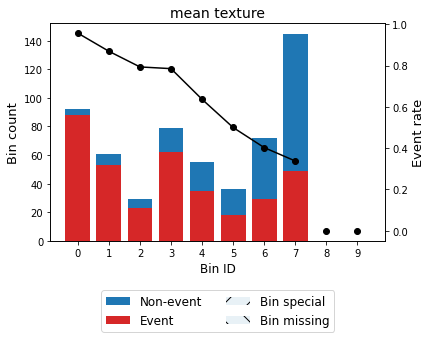
Reduction of dominating bins¶
Version 0.3.0 introduced a new constraint to produce more homogeneous solutions by reducing a concentration metric such as the difference between the largest and smallest bin. The added regularization parameter gamma controls the importance of the reduction term. Larger values specify stronger regularization. Continuing with the previous example
[48]:
optb = OptimalBinning(name=variable, dtype="numerical", solver="cp",
monotonic_trend="descending", gamma=0.5)
optb.fit(x, y)
[48]:
OptimalBinning(gamma=0.5, monotonic_trend='descending', name='mean texture')
[49]:
binning_table = optb.binning_table
binning_table.build()
binning_table.plot(metric="event_rate")
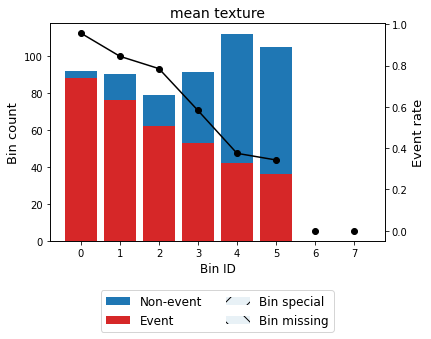
Note that the new solution produces more homogeneous bins, removing the dominance of bin 7 previously observed.
User-defined split points¶
In some situations, we have defined split points or bins required to satisfy a priori belief, knowledge or business constraint. The OptimalBinning permits to pass user-defined split points for numerical variables and user-defined bins for categorical variables. The supplied information is used as a pre-binning, disallowing any pre-binning method set by the user. Furthermore, version 0.5.0 introduces user_splits_fixed parameter, to allow the user to fix some user-defined splits, so these
must appear in the solution.
Example numerical variable:
[50]:
user_splits = [ 14, 15, 16, 17, 20, 21, 22, 27]
user_splits_fixed = [False, True, True, False, False, False, False, False]
[51]:
optb = OptimalBinning(name=variable, dtype="numerical", solver="mip",
user_splits=user_splits, user_splits_fixed=user_splits_fixed)
optb.fit(x, y)
[51]:
OptimalBinning(name='mean texture', solver='mip',
user_splits=[14, 15, 16, 17, 20, 21, 22, 27],
user_splits_fixed=array([False, True, True, False, False, False, False, False]))
[52]:
binning_table = optb.binning_table
binning_table.build()
[52]:
| Bin | Count | Count (%) | Non-event | Event | Event rate | WoE | IV | JS | |
|---|---|---|---|---|---|---|---|---|---|
| 0 | (-inf, 14.00) | 54 | 0.094903 | 2 | 52 | 0.962963 | -2.736947 | 0.372839 | 0.035974 |
| 1 | [14.00, 15.00) | 37 | 0.065026 | 2 | 35 | 0.945946 | -2.341051 | 0.207429 | 0.021268 |
| 2 | [15.00, 16.00) | 43 | 0.075571 | 7 | 36 | 0.837209 | -1.116459 | 0.075720 | 0.009002 |
| 3 | [16.00, 20.00) | 210 | 0.369069 | 59 | 151 | 0.719048 | -0.418593 | 0.060557 | 0.007515 |
| 4 | [20.00, 21.00) | 45 | 0.079086 | 26 | 19 | 0.422222 | 0.834807 | 0.057952 | 0.007041 |
| 5 | [21.00, 22.00) | 49 | 0.086116 | 30 | 19 | 0.387755 | 0.977908 | 0.086338 | 0.010382 |
| 6 | [22.00, 27.00) | 99 | 0.173989 | 71 | 28 | 0.282828 | 1.451625 | 0.372304 | 0.042839 |
| 7 | [27.00, inf) | 32 | 0.056239 | 15 | 17 | 0.531250 | 0.395986 | 0.009161 | 0.001138 |
| 8 | Special | 0 | 0.000000 | 0 | 0 | 0.000000 | 0.000000 | 0.000000 | 0.000000 |
| 9 | Missing | 0 | 0.000000 | 0 | 0 | 0.000000 | 0.000000 | 0.000000 | 0.000000 |
| Totals | 569 | 1.000000 | 212 | 357 | 0.627417 | 1.242301 | 0.135158 |
[53]:
optb.information()
optbinning (Version 0.19.0)
Copyright (c) 2019-2024 Guillermo Navas-Palencia, Apache License 2.0
Name : mean texture
Status : OPTIMAL
Pre-binning statistics
Number of pre-bins 9
Number of refinements 0
Solver statistics
Type mip
Number of variables 137
Number of constraints 55
Objective value 1.2423
Best objective bound 1.2423
Timing
Total time 0.07 sec
Pre-processing 0.00 sec ( 0.26%)
Pre-binning 0.00 sec ( 1.50%)
Solver 0.07 sec ( 97.15%)
Post-processing 0.00 sec ( 0.18%)
Example categorical variable:
[54]:
user_splits = np.array([
['Businessman'],
['Working'],
['Commercial associate'],
['Pensioner', 'Maternity leave'],
['State servant'],
['Unemployed', 'Student']], dtype=object)
[55]:
optb = OptimalBinning(name=variable_cat, dtype="categorical", solver="cp",
user_splits=user_splits,
user_splits_fixed=[False, True, True, True, True, True])
optb.fit(x_cat, y_cat)
[55]:
OptimalBinning(dtype='categorical', name='NAME_INCOME_TYPE',
user_splits=array([list(['Working']), list(['Commercial associate']),
list(['Pensioner', 'Maternity leave']), list(['State servant']),
list(['Unemployed', 'Student'])], dtype=object),
user_splits_fixed=array([ True, True, True, True, True]))
[56]:
binning_table = optb.binning_table
binning_table.build()
[56]:
| Bin | Count | Count (%) | Non-event | Event | Event rate | WoE | IV | JS | |
|---|---|---|---|---|---|---|---|---|---|
| 0 | [Businessman, Pensioner, Maternity leave] | 55377 | 0.180081 | 52393 | 2984 | 0.053885 | 0.433023 | 0.028206 | 0.003499 |
| 1 | [State servant] | 21703 | 0.070576 | 20454 | 1249 | 0.057550 | 0.363350 | 0.008010 | 0.000996 |
| 2 | [Commercial associate] | 71617 | 0.232892 | 66257 | 5360 | 0.074843 | 0.082092 | 0.001516 | 0.000189 |
| 3 | [Working] | 158774 | 0.516320 | 143550 | 15224 | 0.095885 | -0.188675 | 0.019895 | 0.002483 |
| 4 | [Unemployed, Student] | 40 | 0.000130 | 32 | 8 | 0.200000 | -1.046191 | 0.000219 | 0.000026 |
| 5 | Special | 0 | 0.000000 | 0 | 0 | 0.000000 | 0.000000 | 0.000000 | 0.000000 |
| 6 | Missing | 0 | 0.000000 | 0 | 0 | 0.000000 | 0.000000 | 0.000000 | 0.000000 |
| Totals | 307511 | 1.000000 | 282686 | 24825 | 0.080729 | 0.057846 | 0.007193 |
[57]:
optb.binning_table.plot(metric="event_rate")

[58]:
optb.information()
optbinning (Version 0.19.0)
Copyright (c) 2019-2024 Guillermo Navas-Palencia, Apache License 2.0
Name : NAME_INCOME_TYPE
Status : OPTIMAL
Pre-binning statistics
Number of pre-bins 5
Number of refinements 1
Solver statistics
Type cp
Number of booleans 0
Number of branches 0
Number of conflicts 0
Objective value 57843
Best objective bound 57843
Timing
Total time 0.28 sec
Pre-processing 0.04 sec ( 16.31%)
Pre-binning 0.22 sec ( 79.89%)
Solver 0.01 sec ( 3.57%)
model generation 0.01 sec ( 87.30%)
optimizer 0.00 sec ( 12.70%)
Post-processing 0.00 sec ( 0.02%)
Performance: choosing a solver¶
For small problems, say less than max_n_prebins<=20, the solver="mip" tends to be faster than solver="cp". However, for medium and large problems, experiments show the contrary. For very large problems, we recommend the use of the commercial solver LocalSolver via solver="ls". See the specific LocalSolver tutorial.
Missing data and special codes¶
For this example, let’s load data from the FICO Explainable Machine Learning Challenge: https://community.fico.com/s/explainable-machine-learning-challenge
[59]:
df = pd.read_csv("data/FICO_challenge/heloc_dataset_v1.csv", sep=",")
The data dictionary of this challenge includes three special values/codes:
-9 No Bureau Record or No Investigation
-8 No Usable/Valid Trades or Inquiries
-7 Condition not Met (e.g. No Inquiries, No Delinquencies)
[60]:
special_codes = [-9, -8, -7]
[61]:
variable = "AverageMInFile"
x = df[variable].values
y = df.RiskPerformance.values
[62]:
df.RiskPerformance.unique()
[62]:
array(['Bad', 'Good'], dtype=object)
Target is a categorical dichotomic variable, which can be easily transform into numerical.
[63]:
mask = y == "Bad"
y[mask] = 1
y[~mask] = 0
y = y.astype(int)
For the sake of completeness, we include a few missing values
[64]:
idx = np.random.randint(0, len(x), 500)
x = x.astype(float)
x[idx] = np.nan
[65]:
optb = OptimalBinning(name=variable, dtype="numerical", solver="mip",
special_codes=special_codes)
optb.fit(x, y)
[65]:
OptimalBinning(name='AverageMInFile', solver='mip', special_codes=[-9, -8, -7])
[66]:
optb.information(print_level=1)
optbinning (Version 0.19.0)
Copyright (c) 2019-2024 Guillermo Navas-Palencia, Apache License 2.0
Name : AverageMInFile
Status : OPTIMAL
Pre-binning statistics
Number of pre-bins 13
Number of refinements 0
Solver statistics
Type mip
Number of variables 174
Number of constraints 91
Objective value 0.3235
Best objective bound 0.3235
Timing
Total time 0.10 sec
Pre-processing 0.00 sec ( 3.77%)
Pre-binning 0.01 sec ( 8.61%)
Solver 0.09 sec ( 86.93%)
Post-processing 0.00 sec ( 0.11%)
[67]:
binning_table = optb.binning_table
binning_table.build()
[67]:
| Bin | Count | Count (%) | Non-event | Event | Event rate | WoE | IV | JS | |
|---|---|---|---|---|---|---|---|---|---|
| 0 | (-inf, 30.50) | 549 | 0.052491 | 98 | 451 | 0.821494 | -1.438672 | 0.090659 | 0.010446 |
| 1 | [30.50, 48.50) | 1044 | 0.099818 | 286 | 758 | 0.726054 | -0.886864 | 0.072415 | 0.008766 |
| 2 | [48.50, 56.50) | 698 | 0.066737 | 248 | 450 | 0.644699 | -0.507991 | 0.016679 | 0.002063 |
| 3 | [56.50, 64.50) | 928 | 0.088727 | 389 | 539 | 0.580819 | -0.238309 | 0.004989 | 0.000622 |
| 4 | [64.50, 69.50) | 661 | 0.063199 | 301 | 360 | 0.544629 | -0.091166 | 0.000524 | 0.000065 |
| 5 | [69.50, 74.50) | 679 | 0.064920 | 327 | 352 | 0.518409 | 0.014157 | 0.000013 | 0.000002 |
| 6 | [74.50, 81.50) | 901 | 0.086146 | 466 | 435 | 0.482797 | 0.156667 | 0.002117 | 0.000264 |
| 7 | [81.50, 101.50) | 1987 | 0.189980 | 1129 | 858 | 0.431807 | 0.362311 | 0.024865 | 0.003091 |
| 8 | [101.50, 116.50) | 865 | 0.082704 | 540 | 325 | 0.375723 | 0.595572 | 0.028865 | 0.003556 |
| 9 | [116.50, inf) | 1089 | 0.104121 | 706 | 383 | 0.351699 | 0.699408 | 0.049686 | 0.006087 |
| 10 | Special | 565 | 0.054020 | 253 | 312 | 0.552212 | -0.121786 | 0.000798 | 0.000100 |
| 11 | Missing | 493 | 0.047136 | 257 | 236 | 0.478702 | 0.173072 | 0.001414 | 0.000177 |
| Totals | 10459 | 1.000000 | 5000 | 5459 | 0.521943 | 0.293024 | 0.035239 |
Note the dashed bins 10 and 11, corresponding to the special codes bin and the missing bin, respectively.
[68]:
binning_table.plot(metric="event_rate")
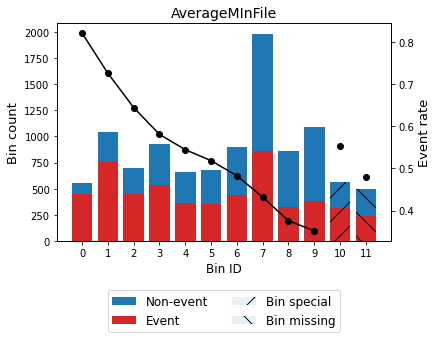
Treat special codes separately¶
Version 0.13.0 introduced the option to pass a dictionary of special codes to treat them separately. This feature provides more flexibility to the modeller. Note that a special code can be a single value or a list of values, for example, a combination of several special values.
[69]:
special_codes = {'special_1': -9, "special_2": -8, "special_3": -7}
x[10:20] = -8
x[100:105] = -7
optb = OptimalBinning(name=variable, dtype="numerical", solver="mip",
special_codes=special_codes)
optb.fit(x, y)
[69]:
OptimalBinning(name='AverageMInFile', solver='mip',
special_codes={'special_1': -9, 'special_2': -8,
'special_3': -7})
[70]:
optb.binning_table.build()
[70]:
| Bin | Count | Count (%) | Non-event | Event | Event rate | WoE | IV | JS | |
|---|---|---|---|---|---|---|---|---|---|
| 0 | (-inf, 30.50) | 548 | 0.052395 | 98 | 450 | 0.821168 | -1.436452 | 0.090256 | 0.010402 |
| 1 | [30.50, 48.50) | 1042 | 0.099627 | 285 | 757 | 0.726488 | -0.889046 | 0.072608 | 0.008788 |
| 2 | [48.50, 56.50) | 698 | 0.066737 | 248 | 450 | 0.644699 | -0.507991 | 0.016679 | 0.002063 |
| 3 | [56.50, 64.50) | 927 | 0.088632 | 389 | 538 | 0.580367 | -0.236452 | 0.004907 | 0.000612 |
| 4 | [64.50, 69.50) | 658 | 0.062912 | 301 | 357 | 0.542553 | -0.082798 | 0.000430 | 0.000054 |
| 5 | [69.50, 74.50) | 679 | 0.064920 | 327 | 352 | 0.518409 | 0.014157 | 0.000013 | 0.000002 |
| 6 | [74.50, 81.50) | 899 | 0.085955 | 466 | 433 | 0.481646 | 0.161276 | 0.002239 | 0.000280 |
| 7 | [81.50, 101.50) | 1984 | 0.189693 | 1128 | 856 | 0.431452 | 0.363759 | 0.025025 | 0.003111 |
| 8 | [101.50, 116.50) | 865 | 0.082704 | 540 | 325 | 0.375723 | 0.595572 | 0.028865 | 0.003556 |
| 9 | [116.50, inf) | 1087 | 0.103930 | 705 | 382 | 0.351426 | 0.700605 | 0.049760 | 0.006096 |
| 10 | special_1 | 565 | 0.054020 | 253 | 312 | 0.552212 | -0.121786 | 0.000798 | 0.000100 |
| 11 | special_2 | 10 | 0.000956 | 2 | 8 | 0.800000 | -1.298467 | 0.001383 | 0.000162 |
| 12 | special_3 | 5 | 0.000478 | 2 | 3 | 0.600000 | -0.317637 | 0.000048 | 0.000006 |
| 13 | Missing | 492 | 0.047041 | 256 | 236 | 0.479675 | 0.169173 | 0.001348 | 0.000168 |
| Totals | 10459 | 1.000000 | 5000 | 5459 | 0.521943 | 0.294358 | 0.035398 |
[71]:
optb.binning_table.plot(metric="event_rate")
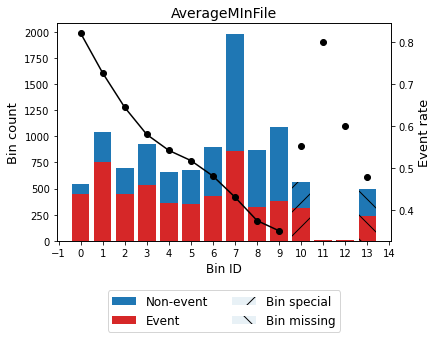
[72]:
special_codes = {'special_1': -9, "special_comb": [-7, -8]}
optb = OptimalBinning(name=variable, dtype="numerical", solver="mip",
special_codes=special_codes)
optb.fit(x, y)
[72]:
OptimalBinning(name='AverageMInFile', solver='mip',
special_codes={'special_1': -9, 'special_comb': [-7, -8]})
[73]:
optb.binning_table.build()
[73]:
| Bin | Count | Count (%) | Non-event | Event | Event rate | WoE | IV | JS | |
|---|---|---|---|---|---|---|---|---|---|
| 0 | (-inf, 30.50) | 548 | 0.052395 | 98 | 450 | 0.821168 | -1.436452 | 0.090256 | 0.010402 |
| 1 | [30.50, 48.50) | 1042 | 0.099627 | 285 | 757 | 0.726488 | -0.889046 | 0.072608 | 0.008788 |
| 2 | [48.50, 56.50) | 698 | 0.066737 | 248 | 450 | 0.644699 | -0.507991 | 0.016679 | 0.002063 |
| 3 | [56.50, 64.50) | 927 | 0.088632 | 389 | 538 | 0.580367 | -0.236452 | 0.004907 | 0.000612 |
| 4 | [64.50, 69.50) | 658 | 0.062912 | 301 | 357 | 0.542553 | -0.082798 | 0.000430 | 0.000054 |
| 5 | [69.50, 74.50) | 679 | 0.064920 | 327 | 352 | 0.518409 | 0.014157 | 0.000013 | 0.000002 |
| 6 | [74.50, 81.50) | 899 | 0.085955 | 466 | 433 | 0.481646 | 0.161276 | 0.002239 | 0.000280 |
| 7 | [81.50, 101.50) | 1984 | 0.189693 | 1128 | 856 | 0.431452 | 0.363759 | 0.025025 | 0.003111 |
| 8 | [101.50, 116.50) | 865 | 0.082704 | 540 | 325 | 0.375723 | 0.595572 | 0.028865 | 0.003556 |
| 9 | [116.50, inf) | 1087 | 0.103930 | 705 | 382 | 0.351426 | 0.700605 | 0.049760 | 0.006096 |
| 10 | special_1 | 565 | 0.054020 | 253 | 312 | 0.552212 | -0.121786 | 0.000798 | 0.000100 |
| 11 | special_comb | 15 | 0.001434 | 4 | 11 | 0.733333 | -0.923773 | 0.001122 | 0.000136 |
| 12 | Missing | 492 | 0.047041 | 256 | 236 | 0.479675 | 0.169173 | 0.001348 | 0.000168 |
| Totals | 10459 | 1.000000 | 5000 | 5459 | 0.521943 | 0.294050 | 0.035366 |
Version 0.15.1 added the option show_bin_labels to show the bin label instead of the bin id on the x-axis.
[74]:
optb.binning_table.plot(metric="event_rate", show_bin_labels=True)
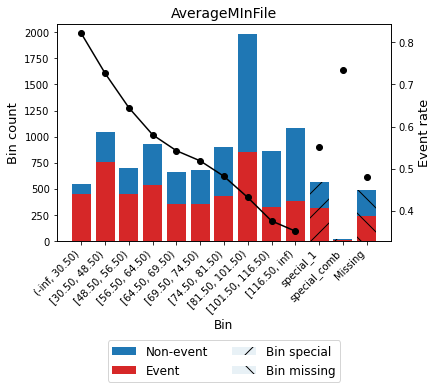
Verbosity option¶
For debugging purposes, we can print information on each step of the computation by triggering the verbose option.
[75]:
optb = OptimalBinning(name=variable, dtype="numerical", solver="mip", verbose=True)
optb.fit(x, y)
2024-01-14 23:33:34,971 | INFO : Optimal binning started.
2024-01-14 23:33:34,973 | INFO : Options: check parameters.
2024-01-14 23:33:34,976 | INFO : Pre-processing started.
2024-01-14 23:33:34,977 | INFO : Pre-processing: number of samples: 10459
2024-01-14 23:33:34,981 | INFO : Pre-processing: number of clean samples: 9967
2024-01-14 23:33:34,982 | INFO : Pre-processing: number of missing samples: 492
2024-01-14 23:33:34,984 | INFO : Pre-processing: number of special samples: 0
2024-01-14 23:33:34,985 | INFO : Pre-processing terminated. Time: 0.0021s
2024-01-14 23:33:34,987 | INFO : Pre-binning started.
2024-01-14 23:33:35,003 | INFO : Pre-binning: number of prebins: 15
2024-01-14 23:33:35,004 | INFO : Pre-binning: number of refinements: 0
2024-01-14 23:33:35,005 | INFO : Pre-binning terminated. Time: 0.0144s
2024-01-14 23:33:35,006 | INFO : Optimizer started.
2024-01-14 23:33:35,008 | INFO : Optimizer: classifier predicts descending monotonic trend.
2024-01-14 23:33:35,010 | INFO : Optimizer: monotonic trend set to descending.
2024-01-14 23:33:35,011 | INFO : Optimizer: build model...
2024-01-14 23:33:35,122 | INFO : Optimizer: solve...
2024-01-14 23:33:35,126 | INFO : Optimizer terminated. Time: 0.1194s
2024-01-14 23:33:35,128 | INFO : Post-processing started.
2024-01-14 23:33:35,130 | INFO : Post-processing: compute binning information.
2024-01-14 23:33:35,133 | INFO : Post-processing terminated. Time: 0.0002s
2024-01-14 23:33:35,135 | INFO : Optimal binning terminated. Status: OPTIMAL. Time: 0.1640s
[75]:
OptimalBinning(name='AverageMInFile', solver='mip', verbose=True)